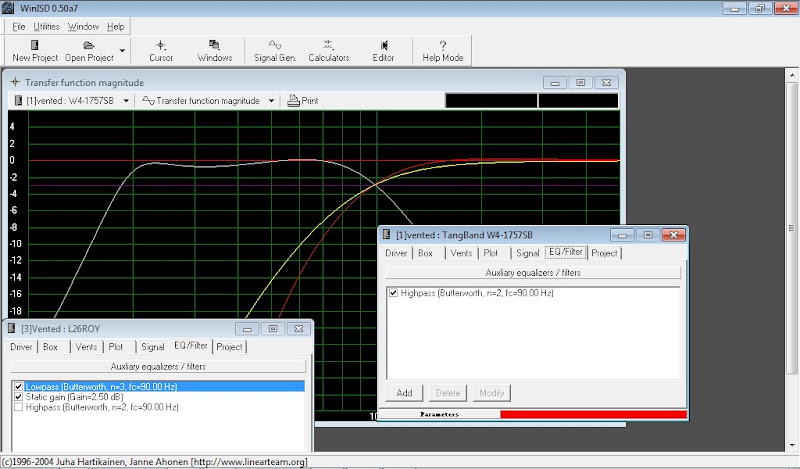Hello, I'm new here, and guess what, I've got questions. 🙂
I tried my hand with WinISD and came up with this:

My AV-amplifier has a fixed subwoofer low-pass filter of 90 Hz, 18dB/oct and a satellite high-pass filter of 90 Hz, 12dB/oct. The idea behind the design was to boost the LF output of the a small 4" ful range driver in a 4 litre enclosure with a vent, and adjust the size of said vent so that the frequency response of the speaker would as flat as possible above 90Hz.
But how does the 12dB and 18dB filters of the amp actually interact with this? I guess there is a way to plot an projection of the combined frequency response of the system, but that is beyound my skill. The goal is good subwoofer and speaker intergration. And yes, the mains and subwoofer might be knitted together with the active filters on the sub, but I'd rather do it right to begin with.
While we're at it: The speaker enclosure would be prefabricated sphere, and the vent would be placed at a right angle to the driver. Is this alright or should the interior end of the vent be bent facing the rear of the driver?
I've posted some other questions in the Ikea bowl speaker thread
http://www.diyaudio.com/forums/multi-way/159151-ikea-spherical-speakers-first-build-done-24.html
...but I felt this part was more general, so I put it here, hope its allright.
TIA,
I:-T
I tried my hand with WinISD and came up with this:

My AV-amplifier has a fixed subwoofer low-pass filter of 90 Hz, 18dB/oct and a satellite high-pass filter of 90 Hz, 12dB/oct. The idea behind the design was to boost the LF output of the a small 4" ful range driver in a 4 litre enclosure with a vent, and adjust the size of said vent so that the frequency response of the speaker would as flat as possible above 90Hz.
But how does the 12dB and 18dB filters of the amp actually interact with this? I guess there is a way to plot an projection of the combined frequency response of the system, but that is beyound my skill. The goal is good subwoofer and speaker intergration. And yes, the mains and subwoofer might be knitted together with the active filters on the sub, but I'd rather do it right to begin with.
While we're at it: The speaker enclosure would be prefabricated sphere, and the vent would be placed at a right angle to the driver. Is this alright or should the interior end of the vent be bent facing the rear of the driver?
I've posted some other questions in the Ikea bowl speaker thread
http://www.diyaudio.com/forums/multi-way/159151-ikea-spherical-speakers-first-build-done-24.html
...but I felt this part was more general, so I put it here, hope its allright.
TIA,
I:-T
Filtered signals
I looked into the filters section of WinISD today, and got one step further. Crossover-corrected currves could look like this:

All curves are filtered with Butterworth filters, Q=0. Represented are a 10" vented subwoofer with a LP filter of 18db/oct, the same woofer in a closed box with HP 12dB/oct as a reference, and a Tangband driver in a 4 litre vented enclosure tuned to 66Hz. The last one is the reddish curve.
Wich filter type and Q values should be used to aproximate the electronic crossovers in an AV-amp? With the Bessel filter, all curves become shallower and the correspondence between the reference and 4 Litre box seems closer.
* * *
I'm assuming the reference represents a idealized example of an satellite where the low-frequency cutoff is mainly done by the amplifier. I'm also supposing that when the subwoofer signal is added, the dip around the crossover point is smoothed out.
The frequency response of the projected 4 litre speaker falls faster than the reference, but at reference -6dB the difference is only about -1dB.
With a more affordable driver (W4-1320SJ "bamboo") the speaker falls off sooner, the difference at the same reference point is -4dB .
Presuming the reference plot is good, what kind of deviation is within accepable range? The goal still being good subwoofer/speaker integration.
TIA!
I:-T
I looked into the filters section of WinISD today, and got one step further. Crossover-corrected currves could look like this:

All curves are filtered with Butterworth filters, Q=0. Represented are a 10" vented subwoofer with a LP filter of 18db/oct, the same woofer in a closed box with HP 12dB/oct as a reference, and a Tangband driver in a 4 litre vented enclosure tuned to 66Hz. The last one is the reddish curve.
Wich filter type and Q values should be used to aproximate the electronic crossovers in an AV-amp? With the Bessel filter, all curves become shallower and the correspondence between the reference and 4 Litre box seems closer.
* * *
I'm assuming the reference represents a idealized example of an satellite where the low-frequency cutoff is mainly done by the amplifier. I'm also supposing that when the subwoofer signal is added, the dip around the crossover point is smoothed out.
The frequency response of the projected 4 litre speaker falls faster than the reference, but at reference -6dB the difference is only about -1dB.
With a more affordable driver (W4-1320SJ "bamboo") the speaker falls off sooner, the difference at the same reference point is -4dB .
Presuming the reference plot is good, what kind of deviation is within accepable range? The goal still being good subwoofer/speaker integration.
TIA!
I:-T
- Status
- Not open for further replies.